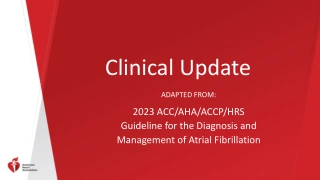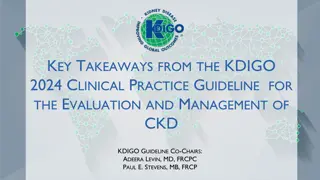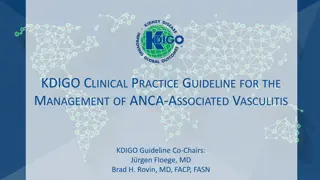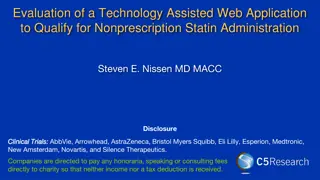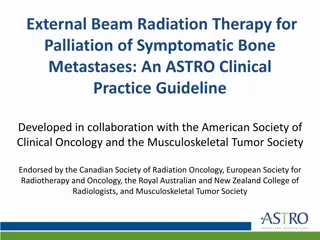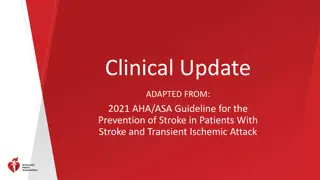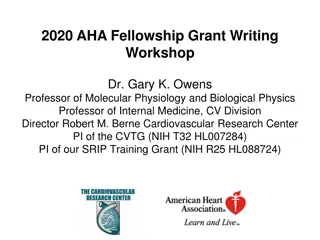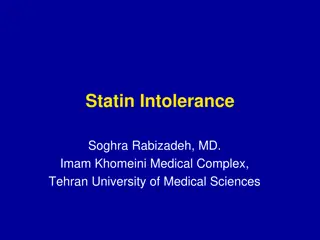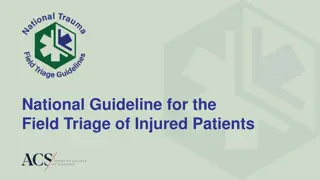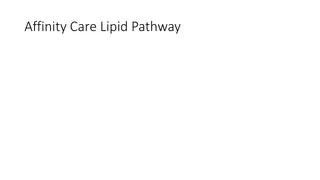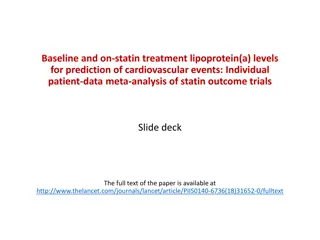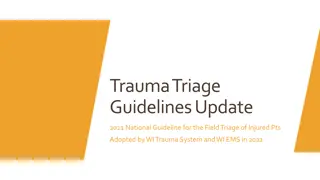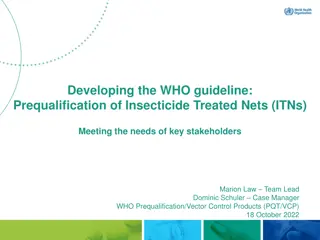Guideline for Statin Management in High-Risk Groups - 2018 ACC/AHA
This guideline outlines the management of blood cholesterol in high-risk groups according to the 2018 ACC/AHA recommendations. It discusses the overall approach, different statin management groups, justification for statin use in high-risk populations, high and moderate-intensity statin therapy, and specific considerations for clinical ASCVD in different age groups. The guideline emphasizes the importance of lifestyle therapies, risk assessment, appropriate statin intensity, and monitoring response in these populations.
Download Presentation

Please find below an Image/Link to download the presentation.
The content on the website is provided AS IS for your information and personal use only. It may not be sold, licensed, or shared on other websites without obtaining consent from the author. Download presentation by click this link. If you encounter any issues during the download, it is possible that the publisher has removed the file from their server.
E N D
Presentation Transcript
Statin Management in High Risk Groups: 2018 ACC/AHA Guideline on the Management of Blood Cholesterol
Purpose Outline highlights from the 2018 ACC/AHA Guideline on the Management of Blood Cholesterol Review statin management in high risk patients 2
ACC/AHA 2018: Overall Approach Lifestyle therapies Assess risk, determine management group Add non-statin therapy for certain high- risk subgroups Monitor response Appropriate- intensity statin Grundy SM, et al. 2018 AHA/ACC Cholesterol Guideline. Circulation. 2019;139:e1082 e1143.
Four Statin Management Groups Age 20 75 LDL-C 190 Clinical ASCVD High risk, No 10-year ASCVD risk calculation required Primary Prevention Diabetes LDL-C 70 189 Primary Prevention No Diabetes LDL-C 70 189 Grundy SM, et al. 2018 AHA/ACC Cholesterol Guideline. Circulation. 2019;139:e1082 e1143. 4
Justification for Statins in High Risk Groups Statin-Eligible Pop. Est ASCVD Prev/Yr 10-yr NNT ASCVD 5,730,000 62,600 9 LDL 190 5,020,000 27,000 19 DM-ASCVD10 7.5% 5,436,000 35,100 15 DM-ASCVD10 <7.5% 3,230,000 4,400 73 5-year NNH = 167 for moderate intensity, 63 for high intensity Egan BM, et al. J Am Heart Assoc. 2016;5:3003558. 5
High and Moderate-Intensity Statin Therapy Moderate- intensity High- intensity Lowers LDL-C on average 50% Lowers LDL-C on average 30 to 49% Atorvastatin 40 80 mg * Atorvastatin 10 20 mg* Rosuvastatin 5 10 mg* Simvastatin 20 40 mg Pravastatin 40 80 mg Lovastatin 40 80 mg Fluvastatin XL 80 mg* Fluvastatin 40 mg bid Pitavastatin 1 4 mg* Rosuvastatin 20 40 mg* *Administer any time of day Grundy SM, et al. 2018 AHA/ACC Cholesterol Guideline. Circulation. 2019;139:e1082 e1143. 6
ACC/AHA: Clinical ASCVD Age 75: High-intensity statin [I: A] Age >75: Moderate-to-high-intensity statin, after considering: [IIa; B] ASCVD risk Potential adverse events Drug-drug interactions Frailty Patient preferences Heart Failure due to ischemic CVD, life expectancy 3+ yrs: Consider moderate-intensity statin [IIb; B-R] Clinical ASCVD Grundy SM, et al. 2018 AHA/ACC Cholesterol Guideline. Circulation. 2019;139:e1082 e1143. 7
ACC/AHA: LDL-C 190 Age 20 75: high-intensity or max tolerated statin [I;B-R] Age 20-75 LDL-C 190 <50% LDL-C reduction or LDL 100 on max tolerated statin: adding ezetimibe reasonable [IIa;B-R] Age 30 to 75, heterozygous FH, LDL-C 100 on max tolerated statin + ezetimibe: Adding PCSK9 inhibitor may be considered [IIb;B-R] Grundy SM, et al. 2018 AHA/ACC Cholesterol Guideline. Circulation. 2019;139:e1082 e1143. 8
ACC/AHA: Primary Prevention in Diabetes Age 40-75: Moderate-intensity statin irrespective of 10-year ASCVD risk Age 40-75 with multiple ASCVD risk factors: High- intensity statin is reasonable [IIa; B] Age 75 on statin: Reasonable to continue statin [IIa; B] Age 75 not on statin: Consider starting after risk / benefit discussion [IIb; C] Age 20-39: Consider starting statin if long duration of DM or microvascular disease or ABI <0.9 [IIb; C] [I; A] Primary Prevention Diabetes LDL-C 70 189 Grundy SM, et al. 2018 AHA/ACC Cholesterol Guideline. Circulation. 2019;139:e1082 e1143. 9
A Note on Interactions Interacting Medication Statin Effect Amiodarone Lova, Simva Increased statin exposure Amlodipine Lova, Simva Increased statin exposure Colchicine All (espec. Atorva, Simva) Increased statin exposure Cyclosporine/tacrolimus Lova, Pitava, Simva, others Increased statin exposure Digoxin Atorva Increased digoxin levels Diltiazem Atorva, Lova, Simva Increased statin exposure Gemfibrozil All Increased statin exposure Ticagrelor Atorva, Lova, Simva Increased statin exposure Verapamil Lova, Simva Increased statin exposure Warfarin Fluva, Lova, Rosuva, Simva Increased INR Key: Use recommended despite interaction, Consider use, Avoid Recommendations for Management of Clinically Significant Drug-Drug Interactions With Statins and Select Agents Used in Patients With Cardiovascular Disease: A Scientific Statement From the American Heart Association. Circulation. 2016;134:e468-e495.
Follow-Up Monitoring after Initiating Statins Lipid panel 4 12 weeks after statin initiation to check adherence Then every 3 12 months, as clinically indicated Responses are defined by % reductions in LDL-C from baseline In ASCVD patients at very high risk, LDL-C 70 trigger consideration on adding non-statin to maximal statin therapy Inadequate response should trigger discussion of medication adherence Don t need to routinely monitor transaminases Grundy SM, et al. 2018 AHA/ACC Cholesterol Guideline. Circulation. 2019;139:e1082 e1143. 11
How do I remember all of this? Take advantage of the ACC s LDL-C Manager (http://tools.acc.org/ldl) Determine management group and initial treatment Determine if your patient has responded appropriately to a statin Available as an app JACC guideline summary: http://www.onlinejacc.org/sites/default/files/additional_assets/guide lines/2018_Cholesterol_Guidelines_Made_Simple_Tool.pdf#page=7
<<Placeholder for center performance>> How are we doing? Insert site-specific data here Review with team performance in each of the three high risk groups
<<Placeholder for next steps>> Given our data, what are we doing to improve? Insert plans for quality improvement and associated timeline




